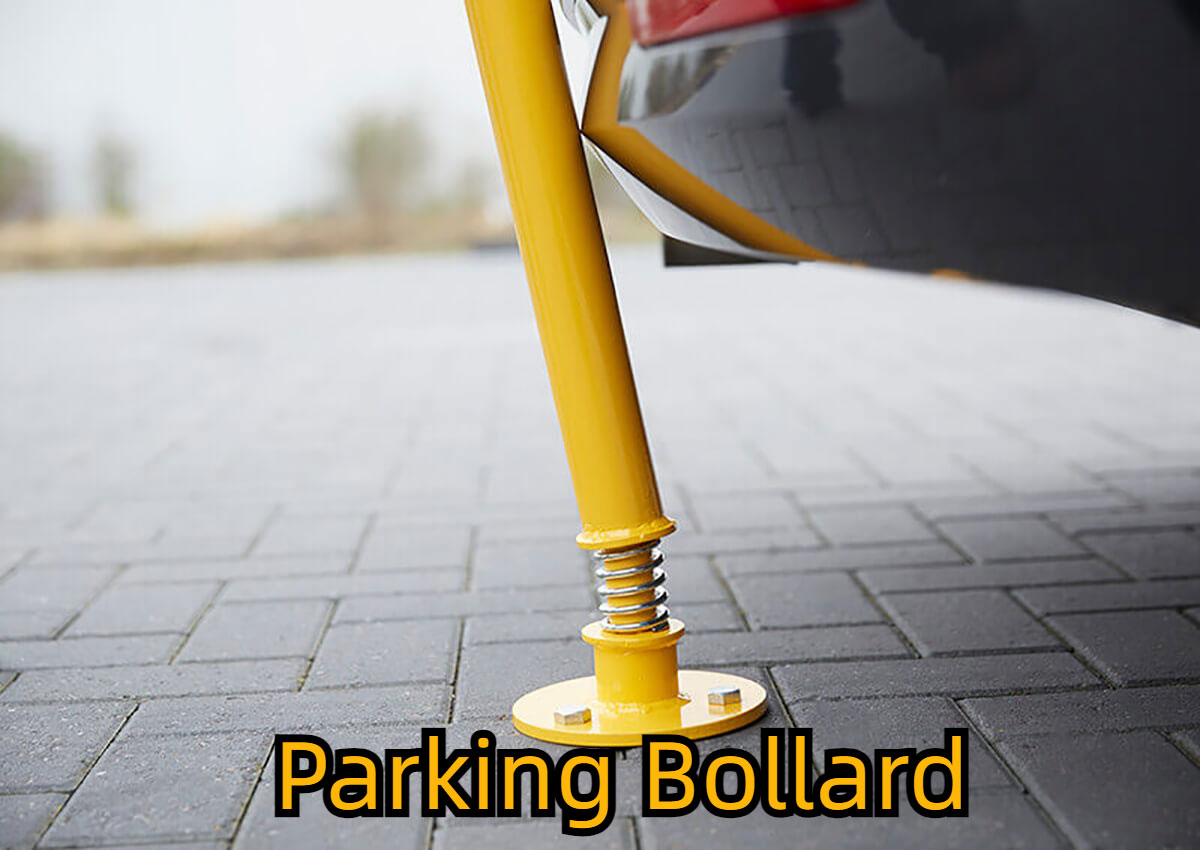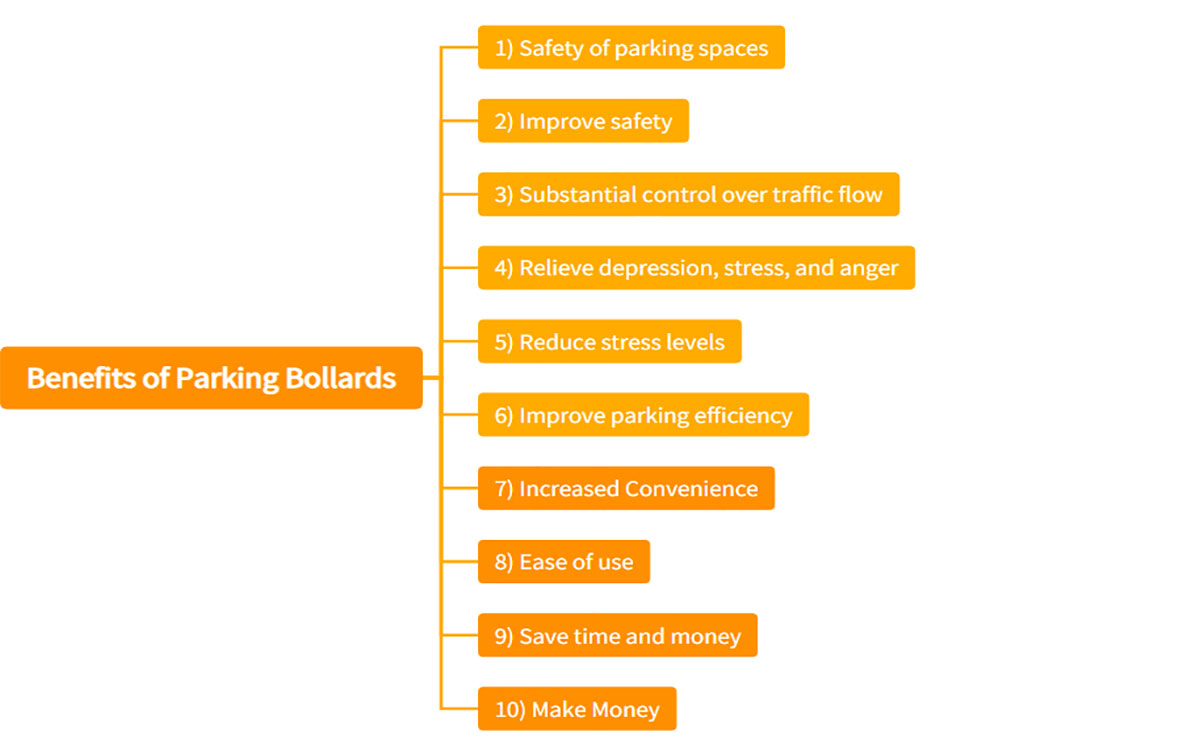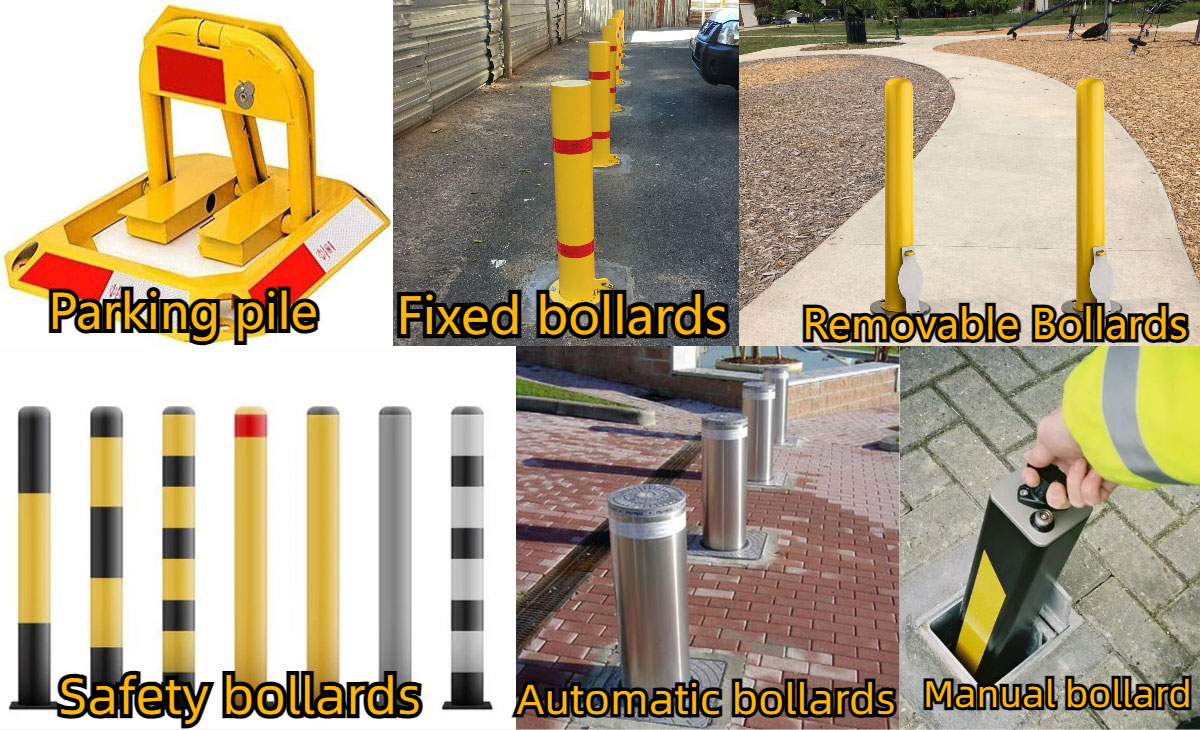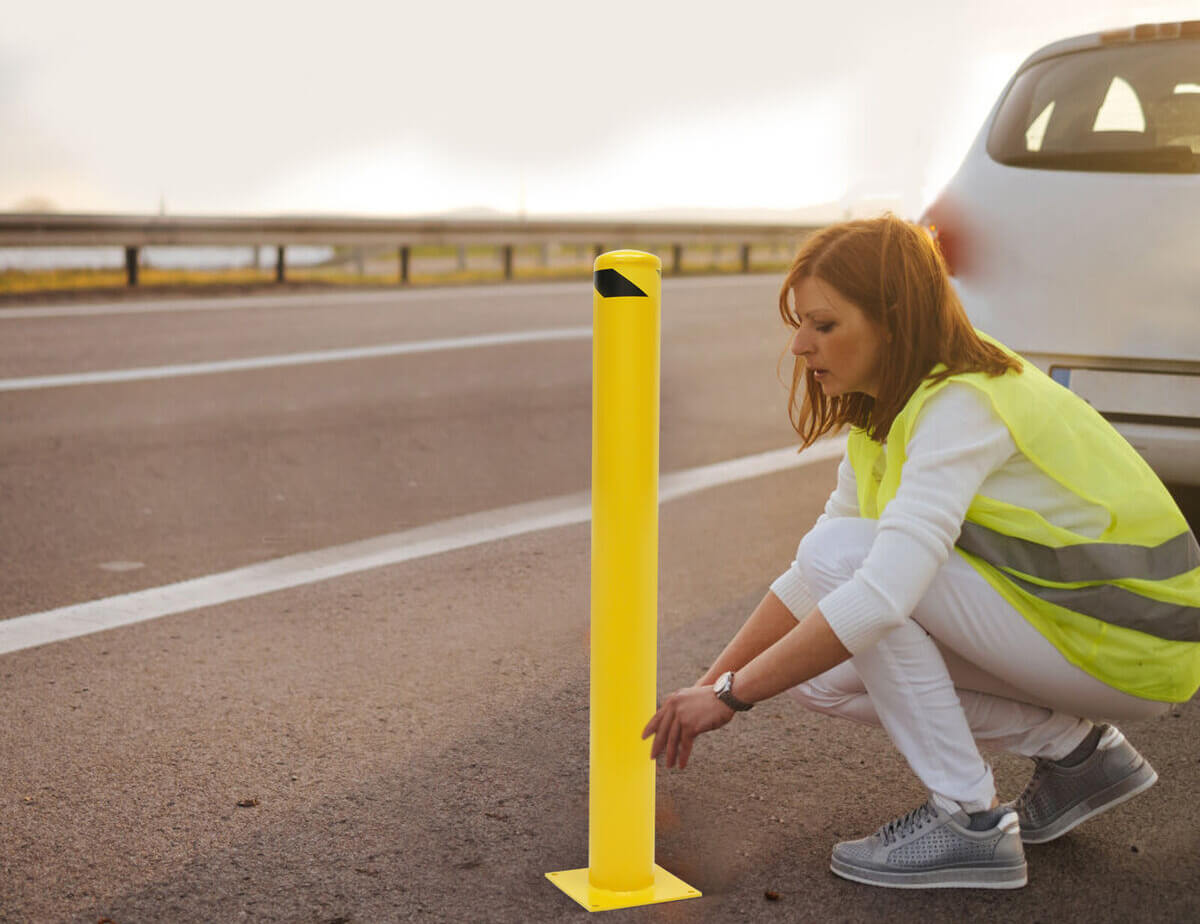The main purpose of a parking bollard is to secure your parking spot when you need it. Other safety bollards are used for safety, especially to delineate the area between pedestrians and vehicles. The parking bollard is both inside the building in the basement of the car park and on the sidewalk. The use of parking bollards for traffic safety has been around since the 18th century, preventing an unknown number of accidents.
Parking bollards can address various issues, including abusive visitor parking, mixed-use retail and commercial designated parking lots, office buildings with flexible working and parking arrangements, disabled parking spaces, and EV charging bay usage.
1. What is a Parking Bollard?
A parking bollard is a short, functional post, installed in the parking lot to protect pedestrians and infrastructure. There are many names for parking bollards. However, they all have the same purpose – to prevent unauthorized drivers from using parking spaces. Parking bollards are commonly referred to by the following terms:
- parking post
- parking lock
- parking barrier
- parking space protector
- parking space protector
- parking guard
- folding parking post
- parking lot guardrail
- parking protector
- parking safety bollard
- parking blocker
These terms apply to any device that prevents people from parking illegally in a parking space.

2. Where are Parking Bollards Usually Found?
You’ve most likely seen parking bollards, but you may not know what they’re called – they’re all around us. These bollard guardrails are typically installed outside airports, banks, shopping malls, and schools. Here are some common places where you can see the parking bollards:
1) Shopping center
One of the main places you’ll find parking posts is in the parking lot of a shopping mall. With such high volumes of vehicle and pedestrian traffic, malls regularly use high-quality bollards for efficient service. They can use safety bollards to keep pedestrians safe and off the road, they can use automatic and manual bollards for their workers, or they can use fixed bollards and safety bollards to protect their assets. Parking-bollards are necessary when more vehicles are entering and exiting a busy location.
2) Workplace
Offices host many people day in and day out, and because parking spaces are too scarce to accommodate workers commuting to work, bollards are often installed. Automatic and manual bollards are most common in these areas, and crews will purchase their own to reserve spots in busy locations. Safety bollards are also common, protecting assets from accidental or deliberate collisions.
3) Entertainment place
Another high-traffic location is one with events or large crowds. Sports bars, gyms, and clubs are just a few of the venues that rely on ground bollards to manage the comings and goings of their guests. A bollard may be placed in an office or shopping center to restrict access to certain bays so only staff and customers are allowed in. In most cases, however, bollards are used to control crowds and protect assets at these venues. Fixed bollards, safety bollards, parking bollards, and safety bollards, are all implemented in these venues.
4) Schools and child care centers
As parents and carers send young children to schools and childcare centers, there must be parking spaces where children can safely get in and out of the car. Childcare centers and schools that offer dedicated parking spaces for customers often find that other people block those spaces.
This prevents parents who need to drop their child off from being able to stop safely to take the child out. This is why parking bollards are often used to very effectively monitor the occupancy of childcare center parking spaces to ensure they are available for safe pick-up and drop-off of children.
5) Electric vehicle charging station
As we begin to replace gasoline or internal combustion engine (ICE) vehicles, more and more electric vehicle charging stations are being installed. Therefore, it is important to ensure that people who own electric vehicles (EVs) and charge them use EV charging stations.
There’s nothing worse than arriving at an EV charging station and seeing someone with a gas car hogging the parking space, so you can’t charge your car. This is called ICEing, and it’s becoming a more common problem in our cities. More and more homeowners are now using parking bollards to protect electric vehicle charging stations.
6) On the road
Bollards are an important aspect of many highways, freeways, and residential areas. For roads, fixed bollards and safety bollards are the most common. Fixed or safety bollards can be found on busy roads to ensure that vehicles do not cross lanes where they are not supposed to change lanes.
They may also be located next to roads to create a dividing line between moving vehicles and cliffs or dams. Security bollards are commonly found in residential areas, especially near and around school areas. They work to keep pedestrians from straying into the road when cars have low visibility or areas too dangerous to cross.

3. Benefits of Parking Bollards
Today, one of the most difficult tasks is controlling fast-moving traffic. This is where security bollards come into play. You need strong physical bollards to control pedestrians, cars, and bicycles on roads and inside buildings. Security and parking bollards are designed to keep people and property safe and protect them.
The purpose of parking bollards is to control restricted areas and prevent accidents. Bollards can also be used to restrict access to certain areas in times of danger. For example, where construction or excavation works are going on near a construction site, in this case, safety bollards protect pedestrians and workers from a safety perspective
Parking bollards are strong, wear-resistant structures designed specifically for parking. They are used to protect parking spaces from being used or vandalized. They should be waterproof, dustproof, and strong enough to withstand vehicles driving over them. Parking bollards provide vehicles with additional parking certainty and help drivers ensure they have assured parking space availability, especially in busy and difficult parking situations.
1) Safety of parking spaces
Parking bollards provide an important driver experience utility to any parking lot. They provide drivers with safety and certainty that they can use designated parking spaces. Safety bollards are also used in car park basements to protect pedestrians, guide drivers, and reduce the chance of car damage.
Pedestrians, shoppers, and motorists will feel safe when they are separated by car parking bollards. They come in different sizes, colors, and materials. Safety bollards are also used to protect structures from being hit by drivers. You can use bollards in parking lots to create a safer environment for pedestrians and drivers while ensuring their vehicles remain safe.
2) Improve safety
Safety and security bollards increase safety in public places by preventing vehicular attacks and restricting cars from entering designated pedestrian areas. They also help regulate the flow of people in crowded spaces, such as museums or theaters, and can be used to enhance the appearance of buildings.
3) Substantial control over traffic flow
Parking and safety bollards improve traffic flow by preventing drivers from driving over the curb and providing a physical bollard to protect pedestrians from injury. Pedestrians and vehicles are protected by bollards, which help maintain public areas as safe and regulated as possible.
Bollards are the best way to control traffic on street curbs, off-street parking spaces, and even in entry and exit areas. In places with heavy traffic, parking restrictions can be difficult to manage. But with bollards, you can create a more controlled and safe environment for weaving between vehicles and pedestrians.
4) Relieve depression, stress, and anger
Finding someone else parked in your parking spot is one of the most annoying things that can happen to you. Illegal parking always creates huge friction, stress, and uneasiness among people. If that’s in your residential building, it can make living there a nightmare if you’re constantly arguing with neighbors or the building manager.
5) Reduce stress levels
Car park bollards are effective in reducing stress levels as they are used to control access and protect parking spaces from unauthorized drivers. By controlling automated bollards, businesses can reduce occupant stress levels and keep their premises safe.
6) Improve parking efficiency
By providing more certainty about parking space availability, parking bollards increase the efficiency of parking lots. This means that if you know you are booking a parking spot, the specific spot you booked is reserved for you, and no one else can use it while you are booking. You can go straight to that parking spot and know it’s reserved for you. Rather than poking around looking for any randomly available parking spot.
This is very important in places like hotels, restaurants, shopping malls, airports, and your office or residential strata buildings. It also means that by actually booking, the asset owner can calculate how often the bay is turned over and increase efficiency. Also, instead of looking around for a parking space, drivers know exactly where their parking space is, secured by parking posts.
For example, I have a friend. He’s a bathroom vanity manufacturer. He often drives himself to various bathroom fairs. Based on his own experience, he suggested that if I was going to on business in the future, I could call ahead and reserve a parking space. This will effectively improve the efficiency of parking.
In addition, that means less carbon emissions because they don’t stand still. Another great thing about parking bollards is that when they are surface mounted, they are very easy to install and comply with Australian building codes. They are also very durable so they last a long time. As such, they can provide a great return on investment when it comes to increasing the value of your parking assets.
7) Increased Convenience
Parking poles increase the convenience of drivers by physically securing their personal parking spaces, thereby enhancing their user experience and convenience. Additionally, bollards can be installed to accommodate the growing electric vehicle market and improve accessibility to charging stations. Or another situation whipped parking spaces need to be reserved for people with real disabilities, not abused by people who just want to park conveniently in empty spaces.
Temporarily securing a parking space with parking-bollards is beneficial for several reasons. Placing bollards on either side of the space can add a layer of protection against vehicles entering or leaving the area. This helps prevent accidents, provides extra, and allows traffic to flow more smoothly when cars are forced to stop in designated areas.
8) Ease of use
Using parking lot bollards is very easy, which is one of their many advantages. So whether you choose a manual parking post operated with a key or a padlock, it’s a simple open and close parking bollard you don’t even want to get out of your car, automatic bollards are perfect. You can use the remote control to operate the remote control parking bollard. Or, if you prefer to use your smartphone, there are smartphone-operated parking bollards.
9) Save time and money
Once a parking bollard is installed, it saves you the time of looking around for available parking spaces. This is because you know your parking space is physically secured with parking bollards. It also saves you money because traveling in circles requires fuel, and fuel costs are sky-high. So every minute of idling will cost you more money unnecessarily. Furthermore, it is harmful to the environment.
10) Make Money
You can make money by installing automated parking bollards in your parking space, which you then rent out. Knowing that there are parking lot bollards installed means that no one else can use the location, so you are guaranteed to make money from other drivers who need to park.
This is a big advantage for parking apps, they can’t guarantee you a parking spot, especially since they can’t physically secure it. We all know that people just don’t respect your parking spot – if it’s available, they’re likely to take it! Especially if your parking spot is in a subway location a busy residential area, or near a commuter train station.

4. Types of Parking Bollards
The following are types of parking bollards.
1) Parking pile
Bollards designed for car parks can range from those placed in car parks to reduce illegal parking to bollards used next to and within car parks to protect pedestrians from moving vehicles. The pegs themselves are usually collapsible when placed in a parking space to allow vehicles to access them when permitted.
Second, parking bollards for security and pedestrian safety are usually fixed and highly visible. They might be illuminated, stacked in reinforced rows, or made of tough steel, but they’re meant to be stable so vehicles can’t access sidewalks.
2) Fixed bollards
These are created to immobilize and stay in place typically for use on roads or to block traffic from entering specific areas. They are usually made of resilient materials such as steel or other metals. They are designed to withstand severe damage and can separate a pedestrian from a moving vehicle, or a moving vehicle from a hazard such as a sharp drop off the edge of the road. Fixed bollards are often designed with bright colors for high visibility and driver compliance.
3) Removable Bollards
Some areas may only require bollards for a short period, such as to meet construction site safety requirements. Another use is crowd and traffic control during large events. Traffic bollards guide traffic and prevent accidents. They also provide clear directions for drivers and pedestrians, letting visitors know what is and is not allowed. Removable bollards are a convenient temporary solution but are not always as strong as fixed or security bollards.
4) Safety bollards
These ground bollards are designed for roadside and parking lot safety. Safety bollards are made of reinforced material and can take the form of parking-bollards or stationary bollards. They emphasize traffic control and are designed to reduce speed in the same way as speed bumps. They are bollards that encourage drivers to drive carefully and pedestrians to pay attention to where they are going. These bollards are often found in schools, roadsides, or busy parking lots.
5) Automatic bollards
For added convenience, automatic bollards provide a seamless way to deter illegal parkers. They are also used by individuals who wish to secure or reserve parking spaces within workplaces or office buildings. Alternatively, they are also purchased by businesses and venues that wish to reserve parking spaces for themselves, their patrons, and staff. Using a remote control or app, drivers can lower automatic bollards without getting out of the car.
6) Manual bollard
Manual bollards have the same function as automatic bollards, the main difference is manual folding. Whether it’s for yourself, employees, or customers, these bollards are useful. While they’re not as convenient as automatic bollards, you’ll find bollard stores offer them for more affordable prices.

5. Where Can I Buy Parking Bollards?
You can buy parking dollies from local suppliers, or online stores that ship nationwide, such as our site at aotons.com. We specialize in all types of parking bollards including manual folding parking bollards, remote control, smartphone bollards, and fixed bollards. Our bollard shop page provides detailed information about parking bollards.
We provide various parking solutions at high-quality and cost-effective prices. Our bollards are tested over and over again and our customer service is outstanding. The best parking bollards are those that are as tried and tested as our products. That’s because they are more durable and can take more abuse.
Options include manual, smartphone, remote control, and collapsible parking poles. Collapsible parking posts for sale are a great option because they are easy to install and fold out of the way. They can be surface-mounted to meet architectural requirements.
Collapsible bollards offer a wide range of security options. They are commonly found at emergency vehicle access, trail entrances, and maintenance entrances. In addition to loading docks, garbage truck reservations, and EV charging areas, they are also used to delineate pedestrian paths.
6. Parking Bollards FAQ
The following are answers to the parking-bollards FAQ.
1) Are the parking bollards suitable for indoor and outdoor use?
Most parking posts for sale are generally suitable for indoor or outdoor use. This will depend on what material they are made of to determine if they are suitable for outdoor activities. At my location, we make sure all of our bollards are suitable for all climates. They have been tested both indoors and outdoors. Our parking-bollards are usually made of galvanized steel with a powder coat finish on top. That’s how we made sure they’re also suitable for outdoor use.
For areas near the ocean, customers often prefer stainless steel grade bollards, which are better able to withstand saline environments. These are, of course, more expensive. They are also more architecturally attractive than powder-coated yellows.
At aotons.com, our automatic parking bollards are water and dust-resistant. They meet the international waterproof standard IP67, so they can withstand rain and dust outdoors. At aotons.com we take great care to ensure our bollards comply with the Australian Parking Industry Standard AS2890.
2) Why buy a manual dock instead of an automatic or smartphone dock?
Which parking bollard you choose to purchase is a balance of personal preference, convenience, application, and cost. Remote or smartphone bollards offer the convenience of operating them without having to get out of your vehicle. Especially when it rains. Manual bollards may be difficult to operate for disabled or elderly drivers due to the added physical exertion.
Smartphone parking poles allow drivers to share access with other users without a remote. Because it’s all done via an app, you don’t even need to be near a smartphone parking post. So using a smartphone parking bollard is very convenient in these situations where there are multiple users.
However, remote control parking-bollards are more expensive than manual parking bollards. As you sell smartphone parking poles, their prices increase as well. Despite being more cost-effective, manual parking-bollards are less convenient. Due to the lack of a motor, manual docks are cheaper than automatic docks. Although you have to get out of the car to operate them.
All manual, remote, and smartphone parking bollards for sale are suitable for both indoor and outdoor use. Therefore, which parking dolls to buy depends more on the type of application for which you need them.
At aotons.com we are very focused on making sure our clients get the best possible advice. We have 15 years experience in the industry and our reputation is very important to us. Therefore, we spend a lot of time guiding you in choosing the best parking solution for your specific situation. We listen to your parking pain points and propose solutions tailored to your needs. This is how we ensure our products deliver the results you need. Take the stress out of parking.
3) When to use fixed bollards?
Fixed bollards are a permanent bollard solution – they are straight and tall and cannot be folded down to provide parking access. They are available in surface mount and buried versions.
The concrete slab or surface is minimally damaged when surface-mounted fixed bollards are installed. Underground bollards require core drilling at the surface, which means some excavation and are therefore not often used indoors in urban buildings.
Fixed parking bollards are most commonly used to protect building assets, restrict access around loading docks, prevent ramming attacks, or provide a clear separation between pedestrian and vehicular traffic for safety reasons.
4) Do I need to buy additional parking post accessories?
Most parking bollards should come with everything you need. This includes keys, fixtures, rechargeable batteries, remote controls, and battery chargers. So generally do not need to buy any additional accessories. At aotons.com, all of our products come with all these items included in the total cost price. So you don’t need to buy any extra parking post accessories.
However, if you want any extra remotes or keys, this can be easily organized. If your family or friends need extra remotes, we can order them. The same goes for extra keys for your manual parking bollards – just ask us. When your rechargeable battery runs out, we always have a spare battery on hand. Lastly, if you lose any part of your parking bollard, we usually have spare parts for the most common things.

7. Conclusion
This guide summarizes the relevant knowledge about parking bollards, please read it carefully to learn more about it.





Leave A Comment